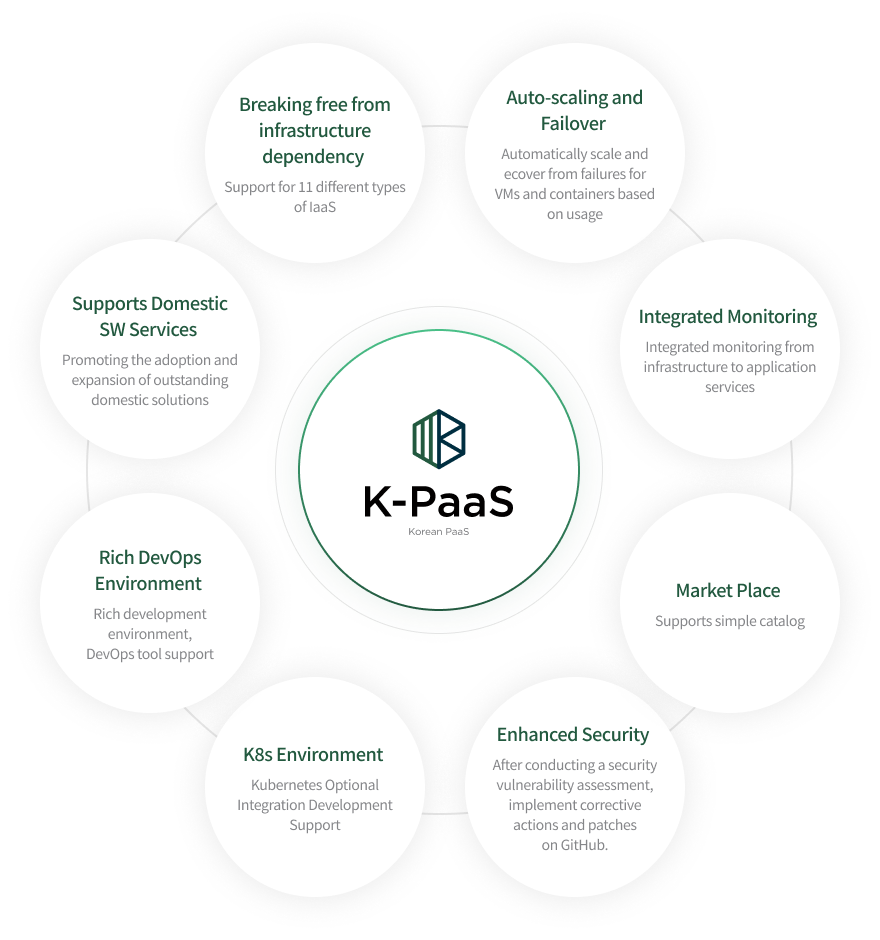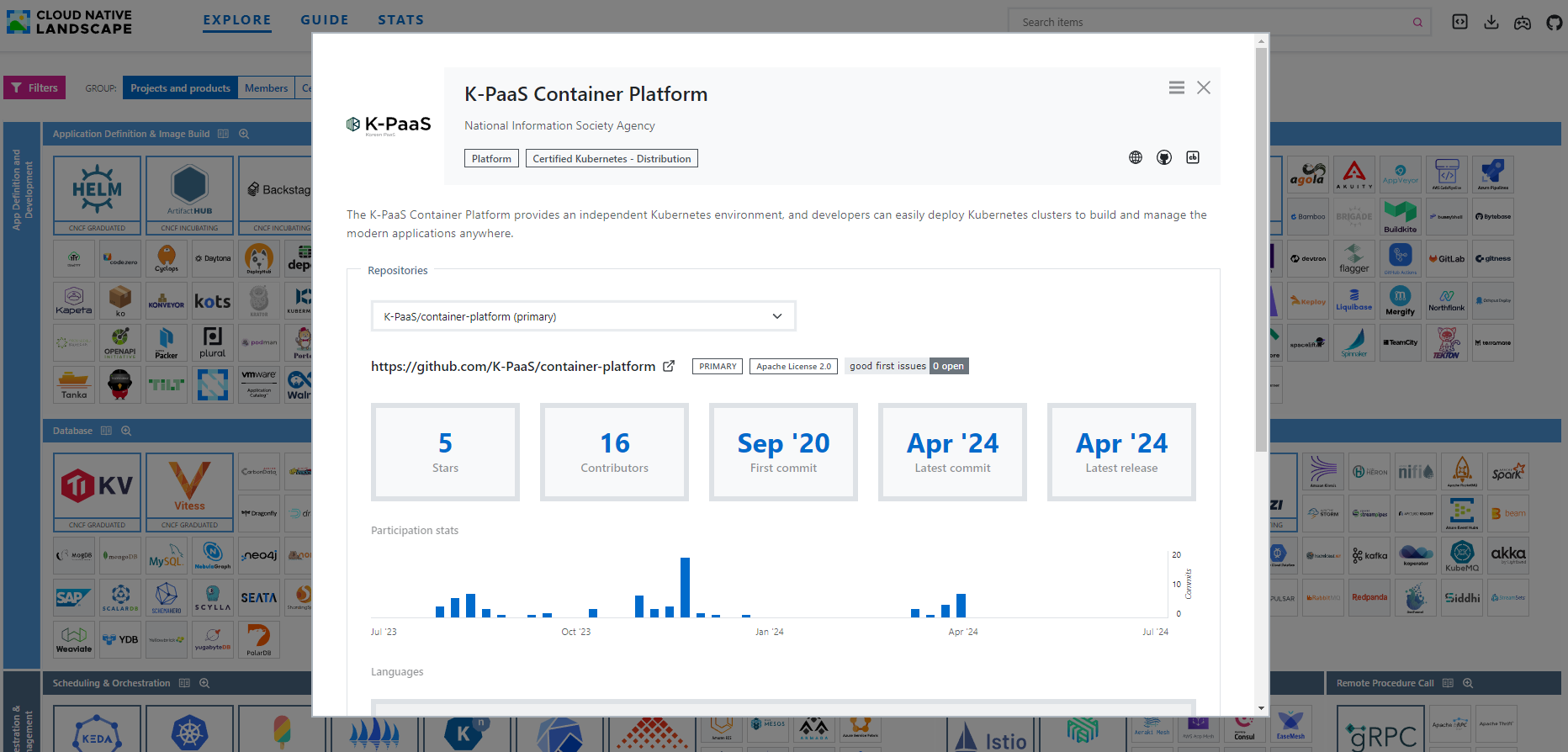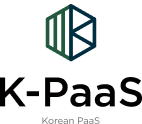ABOUT
What is K-PaaS?
K-PaaS refers to the open cloud platform standard model (K-PaaS standard model, open source)
and cloud platform services and solutions certified for K-PaaS suitability.
To ensure interoperability and operability between cloud platforms, K-PaaS is supported by
the Ministry of Science and ICT and the Korea Intelligence Information Society Promotion Agency, focusing on the Open Cloud Platform Alliance (OPA), a public-private consultative body, and is verifying compatibility and conformity through K-PaaS test certification.
Currently, there are 235 domestic K-PaaS public and private applications for 18 private K-PaaS certified for Conformity.
Supporting IaaS
| Classification | IaaS |
|---|---|
| Private Cloud |
Openstack - Xena |
| VMware vSphere - v7.0 | |
| Cloudit | |
| CONTRABASS | |
| POPCON HCI | |
| Public Cloud |
AWS |
| MS Azure | |
| Google Cloud Platform | |
| NHN Cloud | |
| Naver Cloud | |
| KT Cloud |
Features

Expected Effects
-
- Efficient Utilization
of Hardware Resources - By maximizing
the utilization of hardware resources
based on containers,
IT costs are reduced.
- Efficient Utilization
-
- Rapid Provision
of Software Resources - Automating the installation
and configuration of standardized hardware
and software within minutes enables
rapid development and
testing of application software.
- Rapid Provision
-
- Effortless
SW Maintenance - It is possible to operate the system
stably while maintaining
service levels with a small number
of system operators.
- Effortless
-
- Stable
System Operation - Without requiring separate
solutions for high availability,
it automatically ensures high availability
at both the hardware and software levels.
- Stable
-
- Ensuring
Cloud Mobility - Supports various IaaS platforms
and enables standardized
application software management
through containers.
- Ensuring
Authentication
To confirm that the K-PaaS standard model complies with Kubernetes environmental standards and can provide services reliably, it has obtained Kubernetes certification (CK, Certified Kubernetes) from the CNCF*, an internationally recognized Kubernetes authority (September 10, 2024). * Cloud Native Computing Foundation

Security Vulnerability (CVE, CCE) Inspection and Mitigation Measures (Inspection Period - 2025.01 ~ 2025.10)
Implementation of measures and tests following security vulnerability assessments and provision of security patches)
Periodic OSS inspection and CVE/CCE action and implementation (once every six months)
| Class | CVE | CCE | Details | ||||
|---|---|---|---|---|---|---|---|
| Detection | New Measures | Exception | Detection | New Measures | Exception | ||
| CP Engine - Standalone Deployment | 2 | 1 | 1 | 5 | 0 | 5 | v1.6.1.1 |
| CP Engine - Edge Deployment | 2 | 1 | 1 | 9 | 0 | 9 | v1.6.1.1 |
| TOTAL | 4 | 2 | 2 | 14 | 0 | 14 | |
License
K-PaaS adopts the Apache License, Version 2.0.
However, for external open-source components used within the open cloud platform, the original open-source license policy remains in effect.
- Apache License Version 2.0, January 2004
- TERMS AND CONDITIONS FOE USE, REPRODUCTION, AND DISRTIBUTION.
http://www.apache.org/licenses/
- 1. Definitions
-
"License" shall mean the terms and conditions for use, reproduction, and distribution as defined by Sections
1 through 9 of this document.
"Licensor" shall mean the copyright owner or entity authorized by the copyright owner that is granting the License.
"Legal Entity" shall mean the union of the acting entity and all other entities that control, are controlled by, or are under common control with that entity. For the purposes of this definition, "control" means (i) the power, direct or indirect, to cause the direction or management of such entity, whether by contract or otherwise, or (ii) ownership of fifty percent (50%) or more of the outstanding shares, or (iii) beneficial ownership of such entity.
"You" (or "Your") shall mean an individual or Legal Entity exercising permissions granted by this License.
"Source" form shall mean the preferred form for making modifications, including but not limited to software source code, documentation source, and configuration files.
- 2. Grant of Copyright License
- Subject to the terms and conditions of this License, each Contributor hereby grants to You a perpetual, worldwide, non-exclusive, no-charge, royalty-free, irrevocable copyright license to reproduce, prepare Derivative Works of, publicly display, publicly perform, sublicense, and distribute the Work and such Derivative Works in Source or Object form.
K-PaaS BI
Discover K-PaaS BI, an open cloud platform based on open source.
Meaning to our Business Intelligence
The K-PaaS logo was conceived by integrating the letter K, representing the Korean Wave, into a traditional lattice design, and rendered in the colors of Dancheong patterns.

Use of Logo
Bellow is an use example of K-PaaS logo.
- Horizontal

- Vertical

Color Code
We use colors that are clear, elegant, and clean, aligning with the identity of K-PaaS.
- K-PaaS Color
- C86 M55 Y84 K23
- K-PaaS Color
- C98 M82 Y62 K39
- K-PaaS B&W
- C55 M45 Y41 K0
- K-PaaS B&W
- C92 M88 Y88 K80
K-PaaS Release
You can check the K-PaaS release information.
Click the release link button below to view the latest release link. Previous versions will only display information..
Release Information
-

- K-PaaS 20252025-01-31
-
- The container platform has been upgraded based on Kubernetes version 1.30.4 and KubeEdge version 1.14.2, and these versions have obtained Certified Kubernetes certification..
- Includes multi-cloud deployment packages with domestic cloud service providers, and the services offered enable extensive network expansion based on MSA through Service Mesh. (Multi-cloud deployment is possible via Kubernetes Services from three CSPs.)
- We provide an open-source sample that enables sample deployment using Service Mesh and allows multiple deployment clusters to be used as a single cluster through Federation.
- Through OpenTofu, you can easily create, manage, and monitor additional clusters from the portal. You can also add clusters using various domestic CSPs by adding supported providers.
- The Helm Catalog feature enables the creation of various services through the portal, and the application of Chaos Engine allows for multiple forms of operational testing on applications..


